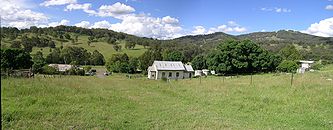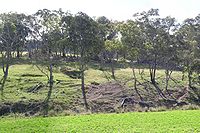
Weabonga, New South Wales
Encyclopedia

Walcha, New South Wales
Walcha is a parish and town at the south-eastern edge of the Northern Tablelands, New South Wales, Australia.The town serves as the seat of Walcha Shire. Walcha is located 425 kilometres by road from Sydney at the intersection of the Oxley Highway and Thunderbolts Way...
, 33 km south southeast of Limbri, New South Wales
Limbri, New South Wales
Limbri is a small village on Swamp Oak Creek, about 30 km east northeast of Tamworth and about 8 km east southeast of Moonbi in northern New South Wales, Australia. The population of the Limbri region in 2006 was 259.Some alluvial gold was found at Limbri...
, Australia
Australia
Australia , officially the Commonwealth of Australia, is a country in the Southern Hemisphere comprising the mainland of the Australian continent, the island of Tasmania, and numerous smaller islands in the Indian and Pacific Oceans. It is the world's sixth-largest country by total area...
. It is lies in the ridges of the Great Dividing Range
Great Dividing Range
The Great Dividing Range, or the Eastern Highlands, is Australia's most substantial mountain range and the third longest in the world. The range stretches more than 3,500 km from Dauan Island off the northeastern tip of Queensland, running the entire length of the eastern coastline through...
and is part of the Tamworth Regional Council
Tamworth Regional Council
Tamworth Regional Council is a Local Government Area in the New England region of New South Wales, Australia. It is on the New England Highway and the Main North railway line.- Incomes :According to the during 2003-04, there:...
Local Government Area
Local Government Area
A local government area is an administrative division of a country that a local government is responsible for. The size of an LGA varies by country but it is generally a subdivision of a state, province, division, or territory....
and Parry County
Parry County, New South Wales
Parry County is one of the 141 Cadastral divisions of New South Wales. It is bounded by the Peel River and Cockburn River on the north, near Tamworth. The Moonbi Range is on the eastern boundary, and the Peel Range on the western boundary. The Great Dividing Range is the boundary to the south-east...
.
The winding Limbri road to Weabonga follows Swamp Oak Creek, which continues on to just north east of Kootingal
Kootingal, New South Wales
Kootingal is a town in New South Wales, Australia in the Tamworth Regional Council area. It is commonly called a satellite suburb of Tamworth because of its closeness and the fact that its residents use Tamworth's services. Founded as an Aboriginal mission, Kootingal traces its name roots to the...
where it joins the Cockburn River
Cockburn River
The Cockburn River is a river in New South Wales, Australia.The Cockburn River rises near Woolbrook, New South Wales in the southern New England tablelands. It drains the western side of the Great Dividing Range...
. Weabonga, situated 749 metres above sea level, has a temperate climate and an average rainfall of 750 to 850 mm per annum.
The countryside varies from open undulating valleys to steep hills. Some abandoned mines may be seen in the region. Native apples, box trees (Eucalyptus melliodora
Eucalyptus melliodora
Eucalyptus melliodora, commonly known as Yellow Box, is a medium sized to occasionally tall eucalypt. The bark is variable ranging from smooth with an irregular, short stocking, to covering most of the trunk, fibrous, dense or loosely held, grey, yellow or red-brown, occasionally very coarse,...
), gums, ironbark, peppermint and stringybark (Eucalyptus caliginosa
Eucalyptus caliginosa
Eucalyptus caliginosa, Broad-leaved Stringybark, New England Stringybark, is a medium sized tree with grey to red-brown, fibrous, stringy, fissured longitudinally, bark with red-brown underlayers to small branches...
) trees are common across the area.
History
Weabonga, meaning “swampgum”, was previously named Rywung, the “resting place”, or Swamp Oak.By 1848 Peter Brodie held a depasturing licence for the 51200 acres (207.2 km²) Swamp Oak Creek run which had an estimated carrying capacity of 1,000 cattle and 8,000 sheep. In 1851 this licence was transferred to his wife and following Peter’s death it went to John Gill. Swamp Oak Creek run’s head station was where Limbri now stands. As usual other outstations were utilised for the day to day management and raising of the sheep. The natural geographic features of this country made it sound grazing country for sheep and there was plenty of shelter for the protection of young lambs.

During December 1890 Swamp Oak Creek Station shore their 20,000 sheep to produce a high quality clip. In January 1891 more miners and their families began to move into the gold diggings further up this creek to Top Station (an outstation of the old Swamp Oak run and now known as Rywung) and Bungendore (another outstation of Swamp Oak run). The mining onslaught then necessitated the removal of the livestock
Livestock
Livestock refers to one or more domesticated animals raised in an agricultural setting to produce commodities such as food, fiber and labor. The term "livestock" as used in this article does not include poultry or farmed fish; however the inclusion of these, especially poultry, within the meaning...
from this region.
Swamp Oak, also known as Rywung, was gazetted as a township on 24 January 1891. Three stores, two butcheries, a bakery, blacksmith and several boarding houses were operating before the end of January 1891. During the following month a post office opened and a mail service was commenced. The 1891 census recorded that there were 130 dwellings, 188 males and 24 females in the town. A police station and Court of Petty Sessions
Magistrates' Court
A magistrates' court or court of petty sessions, formerly known as a police court, is the lowest level of court in England and Wales and many other common law jurisdictions...
was established at Swamp Oak in 1891. The Rywung public school was completed in December 1891. In 1892 a slaughter yard was built by Charles Rowlings at Swamp Oak to provide meat for the miners and their families. Thirty-nine crushing plants were operating at Swamp Oak in 1897.
Most of the gold mining here was in quartz
Quartz
Quartz is the second-most-abundant mineral in the Earth's continental crust, after feldspar. It is made up of a continuous framework of SiO4 silicon–oxygen tetrahedra, with each oxygen being shared between two tetrahedra, giving an overall formula SiO2. There are many different varieties of quartz,...
reefs which necessitated the miners making holes for blasting in the walls and ceiling of mine shafts using a steel rod drill and sledgehammer. Packing the holes with gun powder, they attached long fuses before igniting the explosives from a safe distance. After rock was blasted from the mine face, miners raised the rock to the surface with a hand-operated windlass before placing it into a crusher to be processed. Gold was mined here until at least 1922 when 3 ounces was recorded as having been found by three miners. It was all heavy tiresome work, often for little reward. Manganese
Manganese
Manganese is a chemical element, designated by the symbol Mn. It has the atomic number 25. It is found as a free element in nature , and in many minerals...
and rhodonite
Rhodonite
Rhodonite is a manganese inosilicate, SiO3 and member of the pyroxenoid group of minerals, crystallizing in the triclinic system...
were also mined in significant amounts in the Weabonga area.
In 1912 the Weabonga Church of England was built and dedicated as St George’s. From 1914 to 1929 the NSW Bush Nursing Association formed a branch at Swamp Oak and provided a qualified nurse to administer assistance as required. A public hall was erected in 1916 after fund raising during World War I
World War I
World War I , which was predominantly called the World War or the Great War from its occurrence until 1939, and the First World War or World War I thereafter, was a major war centred in Europe that began on 28 July 1914 and lasted until 11 November 1918...
produced enough money to complete the construction. In 1917 the name of the township of Swamp Oak was changed to Weabonga. There were 120 electors for Weabonga and the surrounding district recorded in the 1928 Tamworth Electoral Roll. A timber Catholic Church was constructed in 1929. The police station was closed in 1944 and the policing is now under the Walcha Road patrol. Rural power was connected to eight Weabonga consumers in 1966. In 1968 the Weabonga (formerly Rywung) school closed owing to a dwindling population.
Some devastating flood damage occurred in the upper reaches of Mulla Creek and around Weabonga when the area was flooded on 28 November 2008, just hours after these photos were taken. The Limbri to Weabonga Road is still cut at the Limbri end and two bridges have been bypassed owing to damage. The Sherrin Bridge bridge on this road was very badly damaged.
Sports
TennisTennis
Tennis is a sport usually played between two players or between two teams of two players each . Each player uses a racket that is strung to strike a hollow rubber ball covered with felt over a net into the opponent's court. Tennis is an Olympic sport and is played at all levels of society at all...
courts were erected below the Royal Standard Hotel in 1893 for the local players. Two public courts were also constructed in the 1920s, but have since fallen into disrepair.
Cricket
Cricket
Cricket is a bat-and-ball game played between two teams of 11 players on an oval-shaped field, at the centre of which is a rectangular 22-yard long pitch. One team bats, trying to score as many runs as possible while the other team bowls and fields, trying to dismiss the batsmen and thus limit the...
teams played against local villages from 1891. A jockey club was formed at Swamp Oak in January 1893 and racing was held at several locations in the region.
The village has the Weabonga Hall and Recreation Ground Committee, caring for the hall and recreation ground. The area is served by the Weabonga Rural Fire Service.
It is now an agricultural based village, with sheep and cattle
Cattle
Cattle are the most common type of large domesticated ungulates. They are a prominent modern member of the subfamily Bovinae, are the most widespread species of the genus Bos, and are most commonly classified collectively as Bos primigenius...
breeding the main pursuits.

